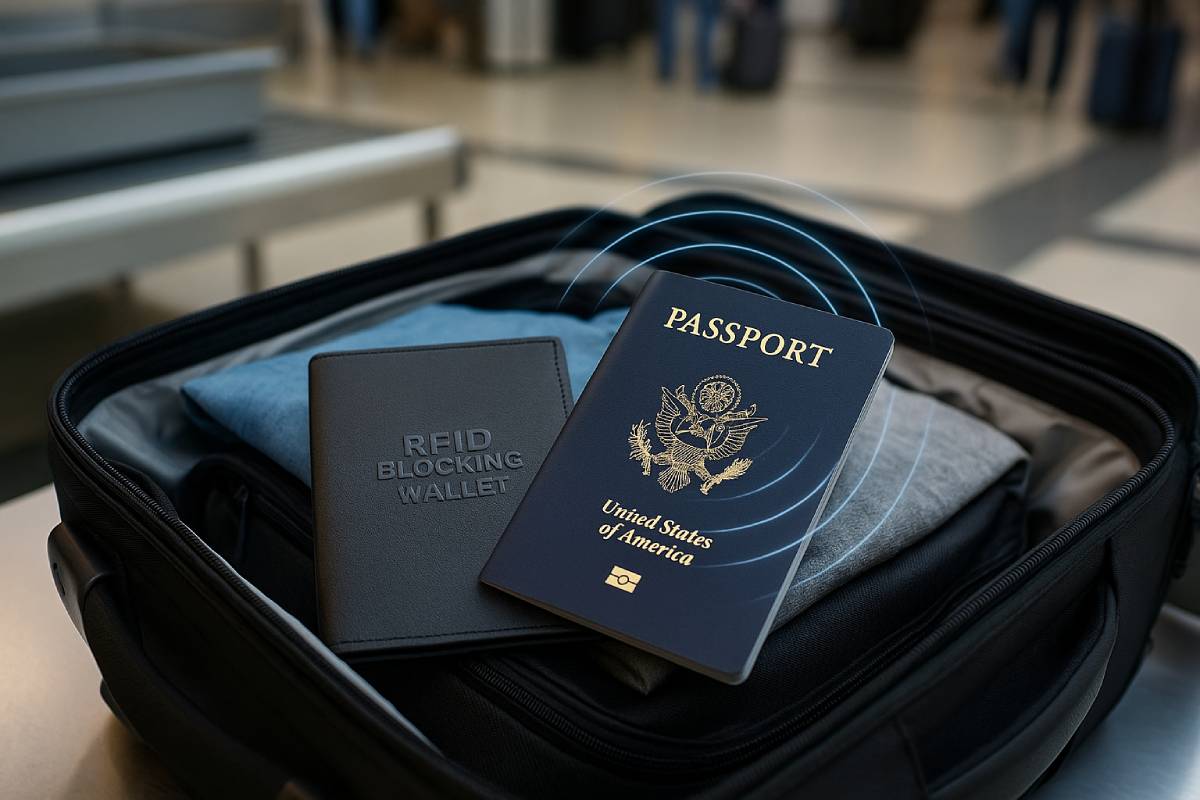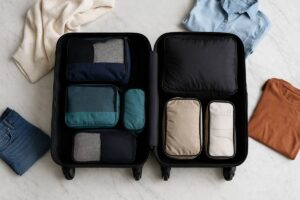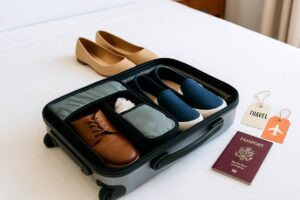With contactless payments now a staple of modern travel, RFID blocking products have flooded the market—but do you really need protection?
While the convenience of RFID-enabled cards offers seamless tap-and-go experiences in airports and beyond, security expert Roger Grimes reports zero documented cases of real-world RFID skimming, making the threat largely theoretical.
Consumer advocates like Frank McKenna and major issuers such as Chase confirm that RFID scams pose no credible threat, urging travelers to focus on conventional fraud protections instead.
As a travel security professional, I’ll break down the actual risks, explain how blocking works, and help you decide if a simple RFID sleeve or a premium Faraday wallet belongs in your carry-on.
Understanding RFID Skimming Risks
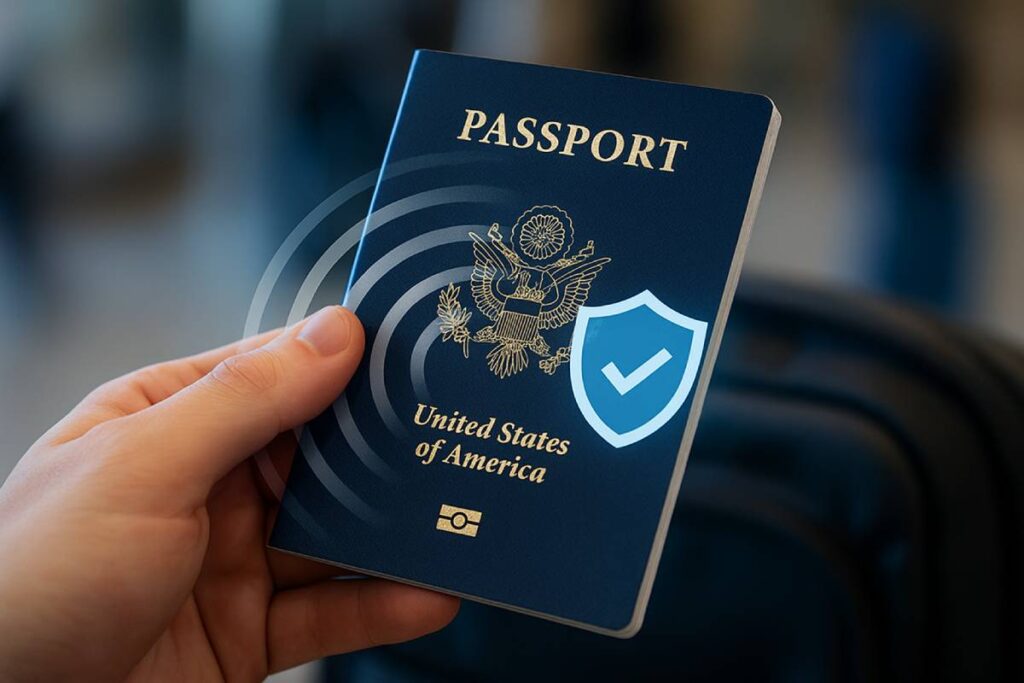
RFID chips in payment cards transmit data over 13.56 MHz with a typical reading range of 5–10 centimeters, and while contactless transactions exceed one billion annually, documented RFID skimming incidents remain virtually non-existent in real-world travel contexts.
By contrast, mag-stripe skimming accounted for over 315,000 compromised cards in 2023 and surged 96% year-over-year, costing consumers more than $1 billion.Meanwhile, online (card-not-present) fraud now comprises 65% of all credit card fraud losses, dwarfing both contactless and mag-stripe threats.
Regional data shows Italy reported 499 skimming incidents in 2020 and Greece 187, but these overwhelmingly targeted mag-stripe vulnerabilities rather than RFID-specific attacks.Anecdotal traveler reports from Europe, Asia, and North America confirm RFID skimming remains a theoretical risk with no verified cases.
How RFID Technology Works
RFID—Radio Frequency Identification—uses radio waves to read and capture information stored on passive chips embedded in credit cards, passports, and keycards. These high-frequency (13.56 MHz) systems require the tag to be within a few inches (5–10 cm) of the reader to power the chip and exchange data.
Passports equipped with e-chip technology can be read only when open and within roughly one foot of an authorized reader under regulatory power limits. Most contactless credit and debit cards employ encryption protocols (e.g., Visa PayWave, MasterCard PayPass) to secure the transmitted data against interception. Keycards for building access often use low-frequency RFID (<134 KHz) with even shorter effective ranges (around 10 cm) to balance convenience and security.
Statistical Overview
Despite the theoretical possibility of RFID skimming, there are virtually no confirmed cases of travelers having card data stolen via an RFID reader in public settings. By contrast, physical skimming of magnetic-stripe cards remains a significant threat: the FBI reports over 315,000 cards were compromised in 2023 due to skimming devices at ATMs and fuel pumps, costing consumers and financial institutions more than $1 billion annually.
FICO data further shows debit card skimming incidents grew by 96% from 2022 to 2023 and jumped 368% between 2021 and 2022, underscoring the enduring risk posed by mag-stripe vulnerabilities. Meanwhile, online (card-not-present) fraud accounts for 65% of all credit card fraud losses, with an estimated CNP fraud rate of 0.93% compared to just 0.06% for in-person transactions.
| Fraud Type | Reported Incidents (2023) | Year-over-Year Change | Fraud Rate |
|---|---|---|---|
| RFID Skimming | 0 documented cases | N/A | N/A |
| Mag-stripe Skimming | 315,000+ cards | +96% (2022–23), +368% (2021–22) | N/A |
| Online (CNP) Fraud | N/A | N/A | 0.93% |
| In-person (CP) Fraud | N/A | N/A | 0.06% |
Destination-Specific Risk Assessments
Risk levels for RFID skimming are uniformly low across regions: Italy recorded 499 skimming incidents in 2020 (12.5% of total) and Greece 187 incidents (4.7%), but these related to mag-stripe attacks rather than RFID‐specific exploits. A TravelHacks community poll among Europe-based travelers found no firsthand RFID skimming events, with users noting they have never encountered an NFC-related incident despite years of EU travel.
Travelers in North America and Asia report similarly negligible practical risk, focusing instead on phishing and ATM skimming as primary fraud concerns. Neither the U.S. Department of State nor the UK Foreign Office travel advisories list RFID skimming as a concern, focusing fraud warnings instead on pickpocketing and ATM fraud.
Expert Opinions on RFID Blocking
Before diving in, here’s the bottom line: Security experts agree that RFID skimming is a theoretical threat, not a practical one, with zero confirmed travel‐related incidents to date. Government standards mandate electromagnetic shielding for federal PIV IDs, and passports now come with built-in Faraday-style covers.
Major card issuers like Visa and Chase reassure consumers that contactless fraud is minimal and encryption makes data capture extremely difficult. In short, RFID blockers offer peace of mind more than real protection—but if you travel with sensitive cards or passports, a lightweight sleeve costs just a few dollars and requires no batteries or software.
Security Professionals’ Consensus
Security analysts across the board agree that RFID skimming is inefficient and virtually unheard of in real-world travel contexts. Roger Grimes, data-driven defense evangelist at KnowBe4, notes “zero real-life RFID crime” despite hundreds of millions of contactless transactions annually. He adds that thieves prefer low-risk, high-volume data from the Dark Web over the complexities of on-the-move RFID attacks.
Digital Trends bluntly summarizes Grimes’s view: “No, they’re a waste of money,” and points out “There has still to this day not been a report of a single real-world crime that an RFID blocking product would have stopped.” . Spero Financial echoes this, stating “RFID skimming is an incredibly inefficient practice” due to encryption and the complexity of matching skimmed data to secure codes.
Even the Identity Theft Resource Center (ITRC) concedes that while an RFID-blocking wallet “provides some extra peace of mind,” it shouldn’t distract consumers from addressing far more common fraud vectors like phishing and mag-stripe skimming.
| Expert/Org | Stance & Quote |
|---|---|
| Roger Grimes (KnowBe4) | “Zero real-life RFID crime” |
| Roger Grimes (Digital Trends) | “No, they’re a waste of money” |
| Spero Financial | “RFID skimming is an incredibly inefficient practice” |
| Distil Union (via Money.com) | “Never a single real-world crime that would have been prevented by an RFID blocker” |
| Identity Theft Resource Center (ITRC) | “Nothing wrong with using a wallet for peace of mind” |
Government & Industry Perspectives
Government Standards & Travel Documents
The U.S. federal government requires FIPS-201–compliant shielding sleeves for Personal Identity Verification (PIV) cards, effectively treating wallets and covers as Faraday cages to protect against unauthorized reads. Likewise, next-generation e-passports include RFID-blocking tape in their covers, ensuring that biometric chips can’t be read unless the passport is open and properly presented.
Card-Issuer Guidance
Consumer protection arms of major issuers reaffirm that RFID fraud is minimal. Visa notes that skimming is “very unlikely and limited in scope,” and Chase’s head of consumer banking practices, Darius Kingsley, says, “I personally don’t worry about this,” urging travelers to focus on card care and transaction monitoring instead.
Debunking Common Myths
| Myth | Reality | Source |
|---|---|---|
| Long-range RFID skimming is common. | Passive RFID/NFC chips require within ~5 cm of a reader to power and communicate. | impinj.kodicam |
| RFID skimmers are a go-to tool for thieves. | FBI and law enforcement focus on mag-stripe skimmers and e-skimming—card-present RFID theft is virtually unheard of. | businessinsider |
| Contactless data is unencrypted. | Cards use one-time, heavily encrypted codes (e.g., Visa PayWave/MasterCard PayPass) that criminal reads can’t use. | okta |
| Mass data theft via RFID is practical. | Mag-stripe skimming alone accounted for over 315,000 compromised cards in 2023, costing $1 billion—far easier to pull off. | businessinsider |
| RFID scanners are a common weapon. | Despite ubiquitous contactless usage, zero confirmed travel-related RFID theft cases exist. | csoonline |
By understanding the technical limitations, expert consensus, and industry guidance, you can decide whether a simple RFID sleeve (often $4–$10 per pack) is worth the few grams of added weight in your carry-on. For most travelers, standard vigilance—keeping cards secured, monitoring statements, and using issuer alerts—provides far more real protection against fraud.
How RFID Blocking Works
RFID blocking gear works by creating a barrier that disrupts or absorbs the radio frequencies used by RFID readers. Most products employ conductive materials—metals or metalized fabrics—to form a “Faraday cage” around your cards or passport chip, effectively attenuating signals by as much as 80–99 dB and reducing read ranges from nearly a meter to under a few centimeters. Below, we explore the core materials, form factors, and real-world effectiveness so you can choose the solution that fits your travel style and budget.
Materials & Technologies
RFID blockers rely on the Faraday cage principle, where a conductive enclosure prevents external radio waves from reaching embedded chips.
- Metalized Fabrics: Copper-, nickel-, or silver-coated textiles are common. For example, premium Faraday fabric with 20 % copper-nickel coating delivers 80–90 dB attenuation from 10 kHz to 30 GHz, with surface resistance as low as 0.03–0.05 Ω/sq.
- Conductive Linings: Many wallets sandwich a thin metallic layer between leather or synthetic panels, cutting read ranges from ~90 cm down to under 5 cm in lab tests.
- Specialty Papers & Films: Military-grade Faraday “paper” or foil-backed films (MIL-STD-188-125 certified) block signals up to 40 GHz and are used in high-end gear.
| Material | Composition | Shielding | Applications |
|---|---|---|---|
| Copper-Nickel Fabric | 20 % Cu/Ni coating on textile | 80–90 dB (10 kHz–30 GHz) | Sleeves, bags, pouches |
| Silver-Coated Nylon | Silver-plated synthetic mesh | ~99.99 % attenuation | Premium wallets, covers |
| Foil-Backed Film | Aluminum/Copper laminate | MIL-STD-188-125 compliant | Tactical cases, heavy-duty bags |
Product Form Factors
Travelers can choose among sleeves, wallets, passport covers, and organizers, each balancing protection with size and convenience.
- Sleeves: Ultra-thin pouches that slip over cards or passports. Extremely lightweight (<10 g) and budget-friendly ($5–$10 per pack), but easy to misplace.
- Bifold Wallets: Standard wallet format with integrated lining. Offer moderate bulk (50–100 g), card capacity, and daily convenience, priced around $20–$40.
- Passport Covers: Hard or soft covers with embedded shielding. Bulky enough to protect the passport and resist bending, typically $10–$25 for multi-packs.
- Travel Organizers: Larger folios or neck wallets that secure multiple documents, cash, and devices. High protection and organization but weigh 200–300 g and cost $30–$80.
| Form Factor | Weight | Convenience | Typical Price |
|---|---|---|---|
| Sleeve | <10 g | Slip-in, minimal bulk | $5–$10 |
| Bifold Wallet | 50–100 g | Fits pocket, everyday use | $20–$40 |
| Passport Cover | 30–60 g | Book-style protection | $10–$25 |
| Travel Organizer | 200–300 g | Multi-item security | $30–$80 |
Practical Effectiveness
Lab tests consistently show that quality RFID blockers stop unauthorized reads at normal carrying distances:
- TitanRF military-grade fabric blocked signals up to 40 GHz under MIL-STD-188-125 protocols.
- Credit Guard blocking cards passed independent lab trials against varied skimmer devices, maintaining full effectiveness after three years of use.
- Consumer-grade wallets reduce NFC read range from ~90 cm to under 5 cm, with only a 2–4 mm thickness increase.
Real-world performance echoes lab findings:
- U.S. passports include built-in shielding in their covers, preventing reads unless the book is open.
- Rick Steves’ travelers report zero RFID skimming incidents, emphasizing other fraud vectors like ATM skimmers instead.
- Durable materials such as tear-proof, waterproof composites hold up under daily wear without losing blocking ability.
Overall, RFID blockers deliver consistent protection in both controlled tests and everyday travel. Your choice should hinge on how you carry your cards and documents: sleeves for minimalist convenience, wallets for daily use, passport covers for dedicated travel, or organizers for maximum security and capacity.
Cost-Benefit Analysis
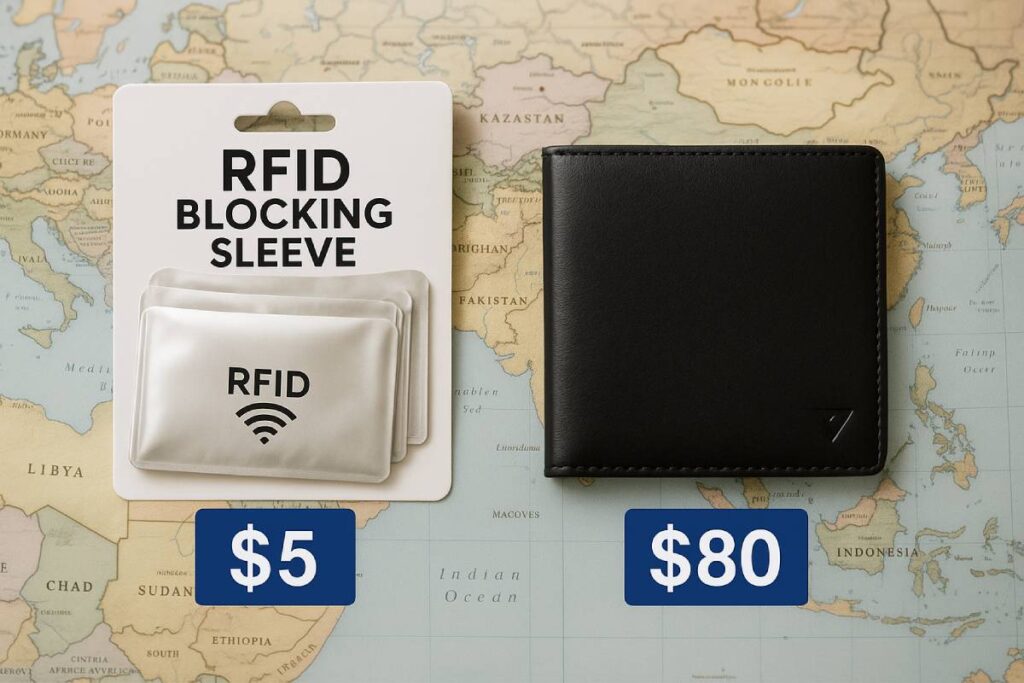
RFID blocking gear runs the gamut from wallet-sized sleeves at under $5 to high-end Faraday-cage wallets exceeding $80, and your choice should balance cost, convenience, and travel frequency. Multi-packs of RFID sleeves typically cost between $4 and $10, offering an ultra-affordable way to guard cards on occasional trips.
Mid-range RFID-blocking wallets priced $17–$40 add durability, card capacity, and style without breaking the bank. Premium Faraday-cage solutions start around $80 and often include heavy-duty materials, tracking features, and extended warranties—but at a steep price.
For travelers on a tight budget or those who prefer minimal gear, DIY hacks using aluminum foil or tin cases can block signals for pennies—but with uneven performance and bulk. Alternatively, non-blocking strategies—like vigilant card care, secure storage, digital wallets, and real-time transaction alerts—offer broad fraud protection without extra accessories.
Budget-Friendly Options
- Multi-packs of RFID Sleeves: You can pick up sets of 10–16 sleeves for as little as $3.99–$9.95, making them ideal for occasional travelers who want lightweight, disposable protection.
- DIY/Alternative Solutions: A simple sleeve made from aluminum foil and clear tape costs under $1 and can be fashioned from household materials—though performance varies and cards may become hard to use.
Mid-Range Wallets
- Price Range: $17–$40 for wallets and small purses with integrated RFID lining.
- Features vs. Price:
- Card Capacity & Access: Many mid-range models (e.g., Card Blocr at $25 and Diomo sling at $26) hold 8–14 cards with quick-access mechanisms.
- Build Quality & Design: Faux leather or water-resistant fabrics offer everyday durability without the bulk of travel organizers.
- Ideal For: Frequent vacationers and business travelers who want a blend of style, function, and protection.
Premium Solutions
- Faraday-Cage Wallets ($80+): Industrial-grade steel or aerospace-fabric wallets (e.g., stainless steel models at $80–$125) provide 99.99% signal attenuation and extreme durability.
- Added Features: Optional Bluetooth tracking, modular inserts, and extended warranties justify the higher cost for frequent flyers and high-value travelers.
- Drawbacks: Heavier weight and significant upfront investment.
Alternatives & Non-Blocking Strategies
- Vigilance & Secure Storage: Lockable luggage, hotel safes, and anti-theft bags deter physical access without RFID gear.
- Digital Wallets & Transaction Alerts: Mobile wallets (Apple Pay, Google Pay) use tokenization and behavioral monitoring, while real-time bank alerts catch suspicious activity instantly.
- Cost: Free or built into your existing banking app—no extra devices or bulk.
| Option | Price Range | Pros | Cons |
|---|---|---|---|
| Budget Sleeves | $4–$10 | Ultra-affordable, lightweight, disposable | Limited durability, easy to lose |
| DIY Solution | <$1 | Near-zero cost, customizable | Inconsistent performance, adds bulk |
| Mid-Range Wallets | $17–$40 | Good protection, stylish designs, moderate durability | Bulkier than sleeves, higher upfront cost |
| Premium Solutions | $80+ | Best shielding, robust materials, tracking features | High cost, heavier |
| Non-Blocking Strategies | Free–Varies | No extra gear, broad fraud protection, always accessible | Requires constant vigilance, reactive vs. proactive |
By aligning your RFID protection choice with travel frequency, destination risk, and budget, you can maximize security ROI—whether that means slipping a $5 sleeve into your carry-on or investing in an $80 Faraday-cage wallet for peace of mind.
Product Recommendations & Use Cases
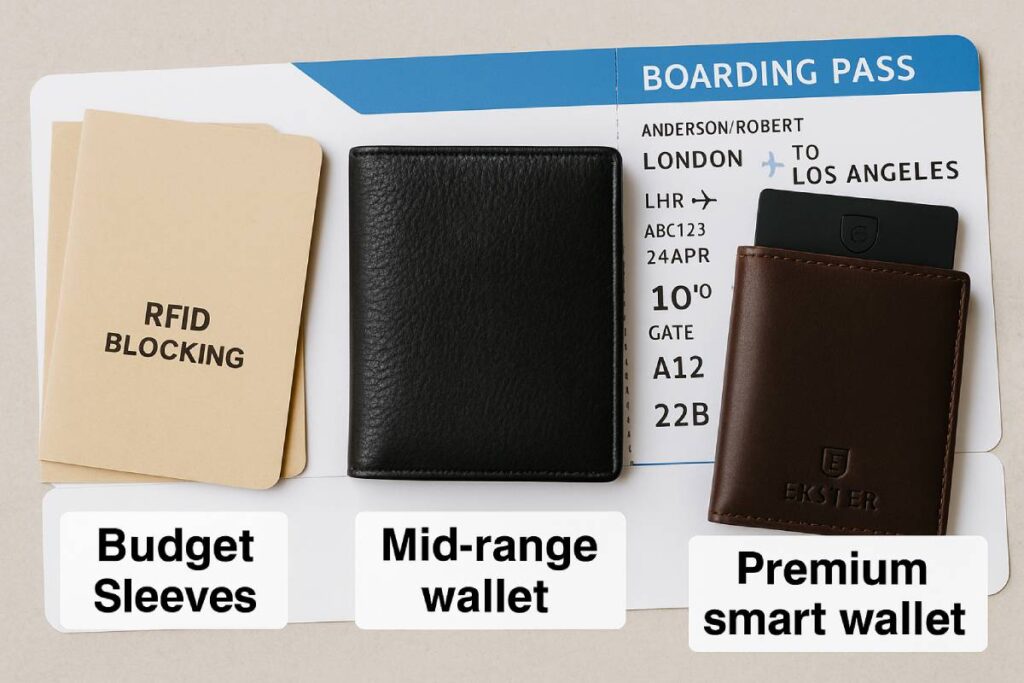
Below is a selection of top-rated RFID-blocking gear organized by price tier and travel style. Each recommendation is chosen for real-world use cases, balancing protection, convenience, and cost.
Top Budget Picks
For occasional travelers or anyone on a tight budget, simple sleeves and no-frills wallets deliver essential RFID protection without breaking the bank.
| Product | Type | Price | Key Features |
|---|---|---|---|
| Travelambo RFID Blocking Wallet | Bifold | $16.99 | 6 card slots, dual bill compartments; vegan leather |
| Zoppen Passport Holder Travel Wallet | Passport cover | $13.00 | 4 card slots, passport pocket, nylon RFID lining |
| ANJ RFID Money Belt | Waist belt | $11.00 | Adjustable strap, hidden zip pocket for cards/cash |
| DIY Aluminum-Foil Sleeve | Sleeve | <$1.00 | Universal fit from household foil, quick hack |
These options cost under $20 and weigh less than 50 g, making them ideal for minimalist carry.
Best for Business Travelers
When you need a professional form factor with reliable RFID blocking for corporate cards and IDs, these mid-range wallets hit the sweet spot between style and security.
| Product | Price | Card Capacity | Extras |
|---|---|---|---|
| Zero Grid Passport Wallet | $29.99 | 8 cards + passport | Water-resistant ripstop nylon; hidden rear pocket |
| Nomatic Slim Wallet | $39.99 | 14 cards | Full-grain leather; quick-access pull tab |
| Pacsafe RFIDsafe V150 Travel Wallet | $49.95 | 10 cards + 2 passports | Slash-resistant eXomesh®; detachable wrist strap |
These wallets look right at home in a briefcase or blazer pocket, with build quality designed for daily business use.
Premium Choices for Frequent Flyers
Frequent travelers carrying multiple cards, passports, and even AirTags often invest in premium Faraday-cage wallets with built-in tracker integration and luxury materials.
- Ekster Parliament Wallet:
Sale $69 (reg $99) for a premium leather smart wallet with a click-fan aluminum cardholder (1–12 cards) and built-in RFID shielding. - Ekster Finder Card:
$49 credit-card-sized tracker that works with Apple® Find My, rechargeable (6-month battery), IPX5 water-resistant. - Ekster Wallet Pro:
$116–$129 leather bifold with custom AirTag pocket, RFID protection, and premium stitching. - Wired Review Spotlight:
“The Ekster Parliament has proven to be a reliable and satisfying accessory, making it potentially the last wallet one might need”.
These solutions pair high-end craftsmanship with the ultimate in travel peace of mind—and come with warranties and trial guarantees.
Destination-Tailored Solutions
Match your RFID protection to your travel context—from off-grid backpacking to executive one-bag carry.
- Backpackers & Adventure Travelers
- ANJ Money Belt ($11): Ultra-slim under-clothes pouch for low-profile concealment.
- Raytix RFID Money Belt ($25): Multi-pocket belt design tested for comfort during long treks.
- Alpha Keeper RFID Money Belt ($24.47): Three-layer blocking material, water-resistant 210D rip-stop nylon.
- Executive & Carry-On Travelers
- Pacsafe GO 34L Anti-Theft Carry-On Backpack ($159.95): Integrated RFID-blocking pocket, slash-resistant construction.
- Zero Grid Travel Neck Wallet ($20): Hands-free passport + card carrier, easy security-line access.
- Pacsafe RFIDsafe V150 Wallet ($49.95): Compact folio with RFID lining and wrist strap, ideal for quick business trips.
By selecting gear tailored to your destination—whether a jungle trek or a corporate summit—you ensure the right balance of security, accessibility, and comfort.
Real-World Traveler Experiences
Across dozens of traveler testimonials, RFID-blocking products consistently deliver peace of mind despite the absence of confirmed skimming incidents. Travelers like Ken from Vernon, Canada, recount experiencing two separate fraud attempts traced to RFID-enabled skimming devices and now won’t travel without a blocking wallet.
In Pack Hacker’s three-week field test of the AmazonBasics RFID Travel Passport Wallet during a trip to Valencia, Spain, the team reported zero attempted scans and praised its organizational convenience.
Thousands of users in GlobeNewswire’s SafeCard reviews—including frequent flyers and digital-security enthusiasts—award the product 4.98 stars for seamless protection in busy transit hubs. Yet false alarms—such as having to remove a blocking wallet to tap a train card in Japan—underscore practical trade-offs.
Business travelers hail RFID money belts as “the smartest travel accessory” for safeguarding corporate cards without bulk; digital nomads favor slim blocking cards that slot into minimalist systems; and budget backpackers rely on $10 multi-packs of RFID sleeves for disposable, cost-effective coverage.
Case Studies
Travelers Credit RFID Blockers for Peace of Mind
- Ken (Rick Steves Forum): After two fraud incidents traced to RFID skimming, Ken now uses an RFID-blocking wallet on every trip.
- Pack Hacker Team: In a three-week Valencia, Spain test of the AmazonBasics RFID Travel Passport Wallet, zero attempted reads occurred, and users praised its document organization.
- SafeCard Users (GlobeNewswire): Thousands of travelers—including businessfolk and security-minded commuters—rate SafeCard 4.98 stars for dependable blocking in airports and public transit.
| Traveler/Source | Experience |
|---|---|
| Ken (Rick Steves Forum) | Two fraud incidents traced to RFID skimming; now always carries a blocking wallet |
| Pack Hacker Team (Pack Hacker) | Zero attempted RFID reads on a 3-week Valencia test; noted improved organization |
| SafeCard Users (GlobeNewswire) | 4.98-star average rating for seamless protection in busy transit hubs |
False Alarms vs. Attempted Scans
- False Alarm: A Reddit traveler reported having to remove an RFID-blocking wallet every time to tap a train fare card in Japan—turning peace of mind into daily hassle.
- No Real Attacks: Pack Hacker’s Valencia case highlighted no real-world skimming attempts, reinforcing that RFID threats remain largely theoretical.
Testimonials from Key Audience Segments
| Segment | Testimonial |
|---|---|
| Business Travelers | “The Peak Gear Travel Money Belt was the smartest travel accessory I’ve ever purchased,” says Business Insider’s Kelsey Mulvey |
| Digital Nomads | “I carry SafeCard in my Ultraminimalist setup—no bulk, just reliable NFC/RFID protection,” report nomadic tech pros according to TechTimes |
| Budget Backpackers | Many budget backpackers opt for Boxiki’s $10.99 multi-pack RFID sleeves for lightweight, disposable card security |
Lessons Learned
- Blocking Saved the Day: Cardian SafeCard users share verified reports of thwarted unauthorized scan attempts in busy airports and transit hubs thanks to passive blocking.
- Peace of Mind vs. Practicality: Thousands of SafeCard reviewers emphasize that even without real skimming events, simply knowing cards are shielded justifies the purchase.
- Common-Sense Security: Travel experts like Rick Steves stress that pickpocketing and magnetic-stripe skimming are far more prevalent than RFID attacks, so conventional vigilance—using money belts, secure bags, and transaction alerts—remains your best defense.
Practical Travel Security Checklist
Here’s a practical, layered travel security checklist that combines “old-school” physical safeguards with smart RFID-blocking tactics and essential digital defenses to keep your valuables—and your data—safe on the road.
Across all measures, the goal is to layer protections so that if one fails, others stand guard—whether you’re hiking in hostels or hopping continent-to-continent on business.
Non-Electronic Protections
Even in our digital age, tried-and-true physical barriers remain your first line of defense.
| Protection | Use Case | Estimated Cost |
|---|---|---|
| Luggage/Padlock | Secure zippers on backpacks, suitcases | $5–$20 per lock |
| Portable Travel Safe | Stash passports, cash in dorm rooms/hotels | $20–$50 portable safe |
| Passport Pouch | Worn under clothing for ID/cash | $10–$25 RFID-blocking models |
| Hotel Room Safe | Store passports, electronics in rooms | Typically free in-room |
- Locks & Safes: Sturdy TSA-approved padlocks and small portable safes deter rummaging in hostels or budget hotels; most digital-nomad guides cite these as essentials.
- Passport Pouches: A slim under-shirt pouch with RFID lining keeps your passport and emergency cash out of sight —and out of range of casual snoops.
- Hotel Safes: Always use the in-room safe (no matter how “secure” it seems): 60 % of travelers admit to leaving valuables unsecured otherwise.
Smart Use of RFID Blockers
Deploy RFID blockers strategically—not everywhere, all the time.
| Scenario | Recommended Gear |
|---|---|
| Quick Day-Trips / Minimal Gear | Single credit-card sleeves ($5/pk) |
| Business Trips / Multiple Cards | Bifold RFID wallet ($20–$40) |
| Multi-Document Journeys | Travel organizer / neck wallet ($30–$80) |
- Sleeves fit into any wallet or pocket and weigh under 10 g—ideal for tap-and-go cards you only use in transit.
- Bifold Wallets with built-in shielding strike a balance between daily convenience and protection for your boarding pass, corporate badge, and up to 12 cards.
- Full Organizers (neck, belt, folio) suit travelers carrying passports, SIM cards, and multiple currencies—especially useful in high-theft urban hubs like Barcelona or Bangkok.
Complementary Digital Measures
Layer in electronic defenses to monitor and react in real time.
| Measure | Benefit | Cost |
|---|---|---|
| Two-Factor Authentication (2FA) | Blocks logins even if passwords are stolen | Free; built into apps |
| Virtual Card Numbers | One-time use cards isolate travel purchases | Free from many banks |
| Real-Time Transaction Alerts | Instant SMS/email on any charge, anywhere | Free with Visa/Mastercard |
| Travel Notices (optional) | Avoids false fraud blocks—keep your bank in the loop | Generally free |
- 2FA: Enabling two-factor on your banking, email, and cloud accounts adds a “second key” even if someone steals your password.
- Virtual Cards: Generate one-off card numbers for hotels or foreign ATMs; if compromised, you simply delete the number—no plastic reissue needed.
- Transaction Alerts: Visa and Mastercard both offer free, near-real-time purchase notifications so you can spot and report unauthorized charges immediately.
- Travel Notices: Though largely obsolete thanks to advanced fraud-detection, setting a travel alert can prevent legitimate purchases from being declined and ensure seamless payments abroad.
By combining physical locks and hotel safes, smart RFID deployment, and digital defenses, you create a robust travel security ecosystem. Adjust each layer to your destination, trip length, and gear loadout to maximize safety—and peace of mind—wherever your adventures take you.
Conclusion
In the end, for most journeys—from bustling metro hubs to remote resorts—the likelihood of RFID skimming remains so low that standard vigilance and banking alerts are usually enough.
However, if you value an extra layer of travel security and peace of mind, lightweight RFID sleeves and blocking wallets offer a cost-effective shield that requires no batteries or software updates.
Compare top-rated RFID blocking travel accessories and find the right protection level for your travel style—whether you’re a frequent flyer or planning your first international getaway.
Balanced Assessment
While RFID chips in passports and credit cards can in principle be read wirelessly, technology experts call RFID scams “very theoretical fraud” and caution that blocking gear offers minimal real-world protection. The cost of blocking products—from foil DIY sleeves to branded Faraday wallets—is low, but so too is the measurable benefit, given the absence of reported RFID theft cases. Most fraud losses still stem from phishing, online scams, and mag-stripe skimmers, which accounted for over 315,000 compromised cards in 2023 and more than $1 billion in losses, underscoring where travelers should focus their vigilance instead.
Tailored Advice
- Occasional Travelers & Budget Voyagers can slip aluminum-foil DIY sleeves (<$1) or inexpensive multi-packs ($5–$10) into any wallet for ad-hoc protection.
- Business Travelers benefit from mid-range RFID wallets ($20–$40) that blend professional styling, 8–14 card capacity, and durable materials for daily commuting and airport security lines.
- Frequent Flyers & Tech-Savvy Nomads may opt for premium Faraday-cage wallets ($80+) featuring Bluetooth trackers, aerospace-grade metals, and extended warranties for ultimate peace of mind.
- Digital-First Security: Supplement physical blockers with two-factor authentication, virtual card numbers, and real-time transaction alerts, which catch fraudulent charges immediately and cost nothing extra.
- Destination-Driven Choices: In high-theft urban hubs, pair an RFID neck pouch with anti-slash bags; on backpacking trips, rely on ultra-slim sleeves to keep weight and bulk to a minimum
FAQs
What is RFID skimming and how common is it?
RFID skimming involves wirelessly reading data from your contactless cards or passports within about 5–10 cm. To date, there are no documented travel-related incidents, making it a theoretical rather than practical threat.
Do RFID blockers really work?
Yes—metalized fabrics and conductive linings form a Faraday cage that can reduce read ranges by up to 90 dB, blocking unauthorized reads.
Is a $5 sleeve enough or should I buy a wallet?
For occasional trips, sleeves (< $10) suffice. Frequent business travelers often choose mid-range wallets ($20–$40) for capacity and convenience.
Can I DIY an RFID blocker?
Yes—you can wrap cards in aluminum foil for under $1, though performance and durability vary.
What other steps boost travel security?
Use 2FA, virtual card numbers, and real-time transaction alerts to catch fraud immediately—these cost nothing but deliver powerful protection.
Main Tips
- Carry a few RFID sleeves for tap-and-go cards you only use in transit.
- Use a mid-range RFID wallet for daily business travel with multiple cards.
- Enable 2FA and real-time transaction alerts on all payment accounts.
- Supplement physical blockers with virtual card numbers for hotel and online bookings.
- Secure valuables in hotel safes and use portable locks for hostels.

